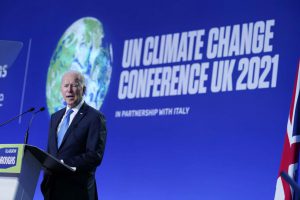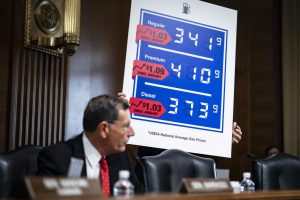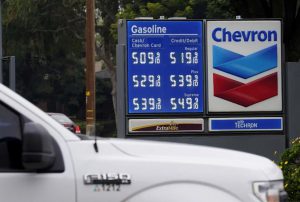NOVEMBER 22, 2021

US President Biden speaks during the “Accelerating Clean Technology Innovation and Deployment” event at the COP26 U.N. climate summit on Nov. 2 in Glasgow, Scotland. (Evan Vucci/Pool/AP)
President Biden, speaking at a global climate summit three weeks ago, called the planet’s warming a “threat to human existence as we know it,” urging the world’s nations to slash the use of fossil fuels and adding, “Action and solidarity, that’s what’s required.”
But facing soaring energy prices at home, Biden is now pushing to crank up the supply of affordable gas and oil for Americans. He is strongly weighing a release from the U.S. Strategic Petroleum Reserve, pushing the Federal Trade Commission to examine whether gas companies are charging too much, and leading a global effort to press oil-producing countries to ramp up production.
Those moves — along with a government auction last Wednesday of oil drilling rights in the Gulf of Mexico — are prompting warnings from environmental advocates that Biden’s push to lower energy prices is undercutting his lofty goals on climate, which he sees as a centerpiece of his legacy.
“There is a huge contradiction right now in their actions,” said Jean Su, who directs the Energy Justice Program at the Center for Biological Diversity, which has sued to stop the oil rights auction. “It’s really all hands on deck right now for climate. . . . Right now is not the time for more oil and gas production.”
The president himself has acknowledged some measure of “irony” in his campaign for more production of fossil fuels — and lower prices that would let Americans burn more of them — as his administration has set a course for net zero greenhouse emissions by 2050.
Biden and his aides say that helping Americans who face an immediate threat from high fuel prices does not undermine his longer-term plans. Biden officials also contend that the short-term measures would not drastically increase emissions. And he, along with his boosters, points to a legislative agenda that includes historic investments in clean energy.
But the president’s immediate conundrum illustrates the challenge facing the United States and other countries trying to shift away from fossil fuels: The near-term needs of their economies, and the pressures of domestic politics, still require cheap oil and gas.
That dilemma was on full display at the White House on Monday, when Biden announced he was nominating Federal Reserve Chair Jerome H. Powell for another term. In his remarks, Biden stressed that Fed policy should take note of climate change, but also noted that high energy prices are a concern, saying, “We know it’s tough for families to keep up with the rising cost of gasoline.”
Republicans have been relentlessly hammering Biden over gas prices, and Democrats inside and outside the White House fear that inflation could be a devastating factor in next year’s midterm elections.
Last Wednesday, as the president traveled to Michigan to promote his infrastructure plan, House Minority Leader Kevin McCarthy (R-Calif.) blasted out an email noting the high fuel costs in that state and accusing Biden of “kneecapping American energy production.”
Republican senators recently held a news conference to highlight the issue, with some of them accusing the White House of purposely stoking the jump in prices to accelerate the transition to renewable energy.
“People for several weeks now have been dealing with the shock of what happens at the gas pump where, every time you go fill your car up with gas, you wonder if you’re going to set your own personal high that day: ‘Is this going to be more than I’ve ever paid for gas before in my life?’ ” Sen. Roy Blunt (R-Mo.) said.
Such attacks are likely to ramp up as winter weather increases the need for heating fuel.

WASHINGTON, DC – NOVEMBER 16: Sen. John Barrasso, R-Wyo., talks about gas prices and inflation during a Senate Energy and Natural Resources Committee hearing on Capitol Hill on Tuesday, Nov. 16, 2021 in Washington, DC. (Photo by Jabin Botsford/The Washington Post)
But while Republicans say Biden’s long-term policies, such as restricting new oil and gas leases, will raise costs, Biden’s recent actions suggest his immediate goal is the opposite.
“Politically, it’s easier to say ‘we’re going to make things cheaper for you’ than ‘we’re going to make things more expensive for you,’ ” said one senior White House official, speaking on the condition of anonymity to discuss internal dynamics.
White House officials also note that gas prices are rising largely because the country is opening up after the pandemic, and demand has increased faster than production.
Some signs suggest the immediate cost crunch is easing, but prices at the pump remain high for now. The average price of gas in the United States as of Monday was $3.41 per gallon, according to AAA. In some politically important states the costs are even higher, with prices at $3.60 per gallon in Biden’s native Pennsylvania and nearly $4 in Nevada.
Biden opponents have slapped stickers on some gas pumps showing the president’s face and his hand gesturing to the total along with the words, “I did that.”
Mark Brownstein, a senior vice president at the Environmental Defense Fund who is in frequent touch with the administration, said Biden’s push for more oil supply is “bad optics” but that he believes the moves are only temporary. The president’s commitment to electric vehicles, and to weaning U.S. transportation from fossil fuels more broadly, is far more important than any short-term jump in supply, Brownstein added.
“There’s the challenge over what we do over the next three to six months to try to tamp down some of the froth in the market that’s stressing the pocketbook of American consumers,” he said. “And then there’s the more systemic solution to the problem.”
Biden’s Build Back Better package, which cleared the House on Friday but faces turbulence in the Senate, includes a $12,500 tax credit to encourage consumers to buy union-built electric vehicles. Emissions from cars, trucks and buses amount to about 30 percent of the country’s greenhouse gas output, according to the Environmental Protection Agency.
Biden’s infrastructure plan, which he recently signed into law, includes $7.5 billion to fund a national network of electric vehicle chargers, a down payment on Biden’s goal of 500,000 of them by 2030.
Some environmentalists sympathetic to Biden say their real worry is Congress, where centrists like Sen. Joe Manchin III (D-W.Va.) have been pushing to scale back the administration’s climate plans.
And they said they recognize that no president can simply wave off social needs like affordable fuel.
“Trying to address climate change for the long term, while recognizing that you have short-term issues — which might be inflation, which might be recession, which might be a global pandemic — that’s not necessarily inconsistent,” said Robert Stavins, director of the Harvard Environmental Economics Program.
But few dispute the notion that it’s a tricky political message for Biden to say that more oil is necessary now, but less oil is vital later.
And there is little doubt that ultimately cheap gas contributes to global warming.
“Anything you do to lower the price of fossil fuels — coal, petroleum — is not supportive of addressing climate change,” Stavins said.
Biden has taken some significant actions to move the U.S. economy away from oil and gas, and at the climate summit in Glasgow, Scotland, he sought to reestablish American leadership on climate change. One of Biden’s first acts in office was signing an executive order requiring a “targeted pause” of new oil and gas leasing on public land.

Prices move over the $5 mark at a Chevron gas station in Visalia, Calif. – Rich Pedroncelli/AP
But last week, under court order, the Biden administration auctioned leasing rights to more that 80 million acres in the Gulf of Mexico, which could generate as much as 1.1 billion barrels of oil and 4.42 trillion cubic feet of natural gas in the coming decades, according to an administration analysis.
The lease has the potential to emit 723 million metric tons of carbon dioxide into the atmosphere over its lifetime — equivalent to operating more than 70 percent of the country’s coal plants for a year, according to a report from the Center for American Progress, a liberal think tank.
The auction was set in motion by the Trump administration but put on hold by the Biden administration. A federal court ruled that sales had to move forward.
“We believe the decision is wrong,” White House press secretary Jen Psaki said. “We’re required to comply with the injunction. It’s a legal case and legal process. But it’s important for advocates and other people out there who are following this to understand that it’s not aligned with our view.”
Some environmental activists are skeptical, saying Biden’s team failed to exhaust all of its options to stop the lease. The administration could have sough a legal stay, said Brettny Hardy, a senior attorney with Earthjustice, and the Interior Department could also have offered a much smaller slice of the Gulf for lease.
Hardy noted that additional leases on public lands are tentatively set for the coming months, including one off the Alaska shore in the Cook Inlet. “This is not at all compatible with the efforts to move away from fossil fuels and address climate,” she said.
Wyn Hornbuckle, a spokesman for the Justice Department, declined to comment, citing the ongoing litigation from environmental groups.
The president has also raised the subject of oil prices with world leaders, including in a virtual summit last week with Chinese President Xi Jinping, where the two discussed the “importance of taking measures to address global energy supplies,” according to a White House account of the conversation.
And just days before attending the Glasgow conference, Biden pushed the Organization of the Petroleum Exporting Countries and other oil-producing nations to ramp up their supply, admitting at the time that it might look like he was sending mixed messages.
“On the surface it seems like an irony,” Biden said. “It does on the surface seem inconsistent.”
But, he argued, the shift from carbon was never going to happen overnight, and meanwhile families urgently need a break on gas prices. “The idea that we’re not going to need gasoline for automobiles is just not realistic,” Biden said. “But we will get to the point . . . by 2050.”
Biden has been firm that he does not want gas prices to get too high, given the effect of such costs on working Americans.
“They have to get to their work,” Biden said. “They have to get in an automobile, turn on the key, get their kids to school. The school buses have to run.”

































































































